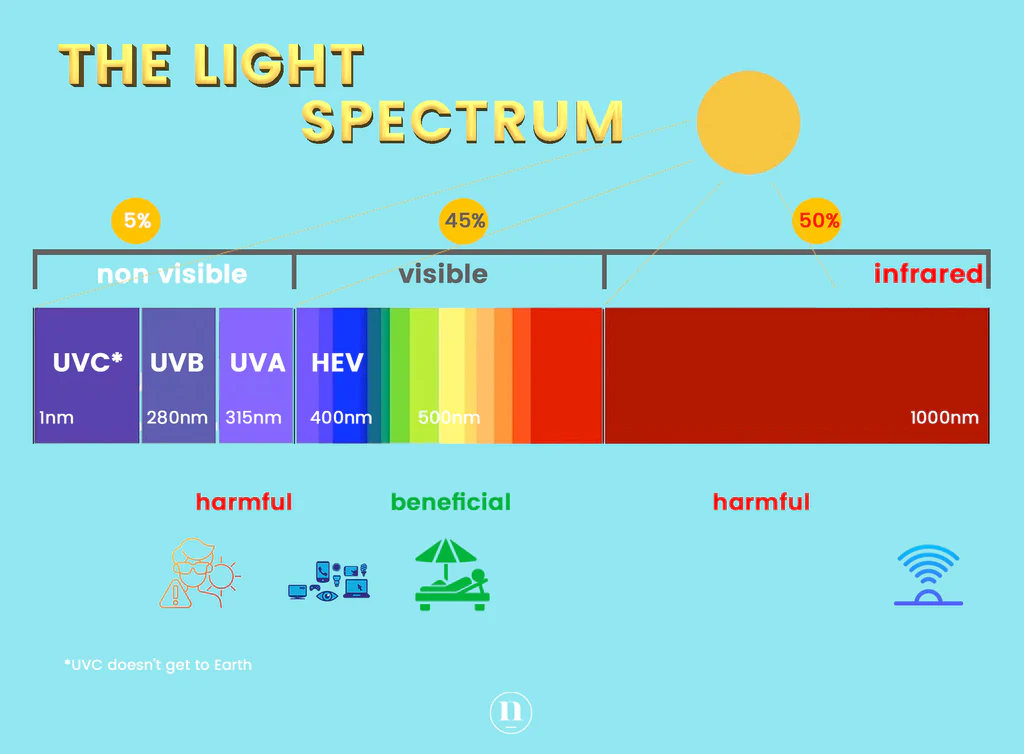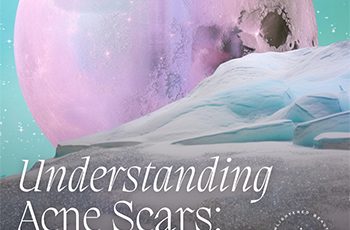
Calling all skin-savvy beauties! Get ready to unlock the ultimate guide to UVA, UVB and HEV to keep your skin radiant and protected like never before.
We are more or less familiar with UV rays, but what about HEV or Blue light? These sneaky rays can have very unpleasant effect on the skin while we work in front of a PC, or when we use our smartphones or even under certain types of LED light. Let’s dig more.
UVA, UVB, and HEV.
We all know it: sunlight is essential to our health, but too much-unprotected sunlight causes skin damage; however, there is another type of light-induced rays, HEV or HEVIS or blue light, that at a particular wavelength, can damage the skin too. So, what are the main differences between UVA, UVB and HEV?
UVA rays have a longer wavelength and can penetrate deep into the skin, all the way to the Dermis. They are associated with premature ageing, wrinkles, DNA damage and skin cancer. UVA rays can also pass through clouds and windows.
UVB rays have a shorter wavelength and concentrate their action on the upper part of the skin, the Epidermis. Controlled exposure to UVB causes the skin to tan, excessive and unprotected exposure causes sunburns and much more. UVB are also associated with potential skin cancer.
HEV (High-Energy Visible) Light also known as blue light, is emitted by the sun as well as electronic devices like smartphones, tablets, screens and LED lights. While HEV light is technically not classified as UV radiation, it can penetrate the skin all the way to the Hypodermis and may contribute to skin damage and premature ageing.
Native Essentials Skincare The Light Spectrum
How do UVA, UVB and HEV penetrate the skin?
While UVB is responsible for visible effects on the top layer of the skin (epidermis), UVA and HEV rays penetrate the skin more deeply (UVA penetrates the dermis, and HEV can even reach the subcutaneous fat of the hypodermis); they can cause damage at a cellular level and oxidative stress, generating free radicals.
While the epidermis functions as the ultimate protective layer of the skin, the dermis is where all the action is: anything that can bypass the epidermis and reach the dermis can alter the production cycle of melanin, collagen, elastin and, most importantly, can interfere with the cell renewal process, aka skin ageing.
What are the effects of sunlight and blue light on the skin?
Exposing our skin to sunlight regularly is crucial to stimulate Vitamin D production. Still, excessive and repeated unprotected skin exposure to sunlight and blue light can lead to various skin-related issues besides increasing the risk of skin cancer.
Remember that slathering on sunscreen, wearing protective clothing, limit the use of electronic devices can prevent:
INCREASED MELANIN = photo-aging, hyperpigmentation, sun allergies, freckles, melasma
HYALURONIC ACID DECREASE = dryness, inflammation, skin texture changes, skin barrier weakened
COLLAGEN FIBERS DAMAGE = fine line and wrinkles, loss of skin tone
DNA DAMAGE = oxidative stress to skin lipids, proteins, cells regeneration slowed
DEGRADED ELASTIN PRODUCTION = loss of elasticity and skin resilience
UNEVEN SKIN STRUCTURE = subcutaneous fat changes, impaired skin support
Is HEV/Blue Light as dangerous as UV?
As our lives become increasingly screen-centric, limited research suggests that Blue light emitted by electronic devices, harms our skin, especially at specific wavelengths. A 2019 study reports that blue light could increase free-radical production, DNA damage and trigger inflammation, thus potentially accelerating ageing. No studies so far have associated HEV with skin cancer, but beyond that, the damage it does to our circadian rhythms and eyes is well-researched.
If we had a face-off between UV and HEV, here are the facts:
- Intensity
Excessive UV rays can damage both the epidermis and the dermis, while HEV typically skips the top layer (epidermis) and penetrates directly into the dermis and possibly all the way to the subcutaneous fat. - Exposure
UV rays are sneaky as they can lurk in sunlight, tanning beds, and even on cloudy days. All year round. Blue light, on the other hand, mainly emanates from digital screens, LED lights, and fluorescent lights that can be easily controlled. - Research & Evidence
Here’s where things get tricky. While we’ve known about the harmful effects of UV rays for ages, the research on HEV blue light is still in its early stages. Some studies suggest prolonged exposure to blue light might disrupt our sleep patterns and potentially contribute to skin issues. However, more research is needed to understand the extent of its impact fully. - The Verdict
It’s too soon to declare a clear winner. UV rays have a proven track record of skin damage, including skin cancer. However, the potential dangers of HEV blue light cannot be completely dismissed. While it might not be as potent as UV rays, it’s wise to exercise caution, minimize unnecessary exposure to both and use skincare with HEV filters.
Which skincare ingredients can filter UV and HEV?
Several skincare ingredients can help protect the skin from UV (ultraviolet) and HEV (high-energy visible) light. Here are some filters and ingredients known for their protective properties:
Zinc Oxide is a broad-spectrum physical sunscreen ingredient that protects against UVA and UVB rays. It also helps to block HEV light.
Titanium Dioxide is a physical sunscreen ingredient that offers almost broad-spectrum protection against UVA and UVB rays when combined with zinc oxide. It can also provide some defense against HEV or blue light.
Iron oxide is another physical sunscreen agent that can help protect against UV and HEV or blue light, especially when combined with zinc oxide. Iron oxides are mineral pigments of various shades often used to add the ‘tint’ to tinted sunscreen formulas.
New generation broad spectrum chemical filters (bis-ethylhexyloxyphenol methoxyphenyl triazine methylene bis-benzotriazolyl tetramethylbutylphenol) that absorb UV rays and turn them into heat.
Antioxidants Vitamin C, and Vitamin E, can help protect the skin from free radicals generated by UV and HEV light exposure. They neutralize the damaging effects of these free radicals and may offer some protection.
Marine microalgae fight free radicals while protecting the skin against the damage of HEV or blue light.
Remember that while these ingredients can offer some level of protection, it’s still essential to use broad-spectrum sunscreen with a high SPF (50+) + PA ratings (+++/+), as well as practice other sun protection measures like wearing protective clothing and seeking shade during peak sun hours.


